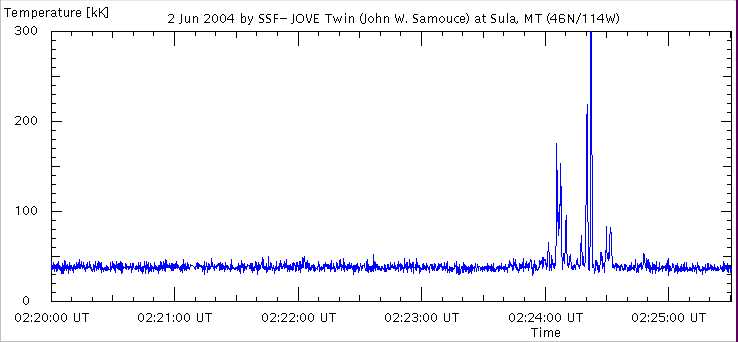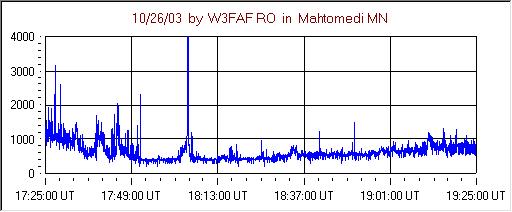Subjects to Explore with the Data
Joachim Köppen DF3GJ Kiel/Strasbourg/Illkirch Summer 2004
Here are a few examples of subjects that could be explored:
- search for possible solar radio bursts. The NOAA solar activity
archive
for 2004 gives the information of all identified solar bursts, and
the
Radio Jove Data Archive
at GSFC are also very helpful.
- some type of solar radio bursts have a characteristic shape:
they look like shark fins, rising quickly but going down more slowly.
Maybe you find some candidate bursts that are not listed in the
NOAA data!
Recently while listening, I happend to hear an increase
of the noise, fast rising - slowly falling. It was nice clean
rushing noise, unlike any interference or communication.
Later, the NOAA list showed that it had indeed been solar event
No. 3200 of 15 June 2004, a type III/1 radio burst!
- the twilight and night-time data should be hunted for
Jupiter bursts -
check whether at the times suggested by the Jove prediction
software there are bunches of impulses.
{However, during this summer, Jupiter will be above the
horizon only during the day. Solar noise and noise from
the ionosphere as well all radio emissions reflected by the
ionosphere will be too strong to hear much of Jupiter!)
But who knows? Maybe you catch Jupiter just after sunset!
Anyway, we must have a very low background, such as seen
in this recent observation. John has an enviously low noise site;
the background of about 35 kK would come mostly from the
Milky Way:

- How does the background noise level and the amount of
daytime impulse noise vary with time of the day and time
of the week? What is natural, what is man-made?
- Watch out for changes in the background: it could be that some
man-made interferences starts or stops, that the ionospheric
conditions change the reflection of short wave signals, or even
we might experience that the ionosphere becomes opaque as a
consequence of a strong influx of solar particles (Mögel-Dellinger
effect) which cause short wave communication to break down...
Here are two examples during the huge solar storms in October 2003:


- Some of the impulse-type noise comes from lightning discharges
in thunderstorms. On the Web, one may obtain real-time maps of
the lightning activity in any area of the Earth. How does the occurrence
of crashing-type pulses relate to the presence of thunderstorms
in your area? Can one say at which distances the interference
becomes noticeable?
- Do you notice anything in the level of the noise around
sunrise or sunset? Can we pick up the emission of the
quiet sun? Are we sensitive enough?
- Is the rise of noise in the morning the mirror image of the
decrease of noise in the evening?
- Can we pickup signals from the centre of the Milky Way?
During July and August, Sagittarius is culminating in the night,
so we might see any significant increase of noise about the
time when it's in the peak of the antenna pattern?
Jason Shinn from Canal Fulton, Ohio captured this extraordinary
beautiful plot in August 2004:

One sees very nicely the strong daytime noise stopping at about
03 UT - which is local evening. Nonetheless, the emission from
the Milky Way was already present, it peaks when the Galactic
Centre culminates over Ohio ("Local Transit"). During the following
night the signal becomes weaker, and vanishes, as the Galactic
Centre sets at about 07 UT. Later, the daytime noise appears again!
- How stable is the calibration of the receiver? Do the calibrations
taken at the beginning and the end of your observation run (with the
same receiver and the same volume setting) give the same readings?
- the most pertinent problem in Strasbourg in winter has
been the mystery of the origin of the periodic night-time
interference.
Since the exchange of the flickering street lamp in front of the
ISU building has not prevented the interference to come back
at times, we still are faced with the problem:
What can we do to
find and prove its origin? What in the characteristics of
the signal (repetition period, on-off ratio, start/stop times)
could give us a hint? For example: the period seems to be
quite constant: 47 sec. How constant is it? How does the
amplitude (high value/low value of noise level) vary?
Variations from day-to-day? Difference between week and
weekend?
- If it continues to be present and if we cannot do anything about it,
e.g. by fixing a faulty equipment, could we do some clever
processing of the data to help us pick real signals? For instance,
during the 10 sec interval of low noise, the level seems to be just
below 100000 K, only twice of the galactic background: so it might
still be possible to pick up bursts from Jupiter.
- Wherever you run the RadioJove receiver, you might be faced with
similar or different problems ...
No need to dispair! A careful study of any
problem or interference might turn out to be as challenging and exciting
as detecting signals from Little Green Men ... Only with
meticulous studies and clever approaches you have a chance to
identify the source, uncover perhaps some weird physical effect
causing it to behave like that, and then fix it!
- There are many events of short impulses during the day. Is there
a possibility to identify these impulses and build a software filter
to remove them? Any clever ideas?
- I've written a Java program SkyPipePlotter which can read
the data files. It
permits to calibrate the data (with the signals done by the
calibration sequence) and to display the data in proper units
(dB over room temperature, or noise temperature).
This could be used to make some data processing ...
You might devise some signal processing techniques which
we can add to the program. The source code would be at your
disposition.
| Top of the Page
| back to Main Page
| back to my Home Page
|



